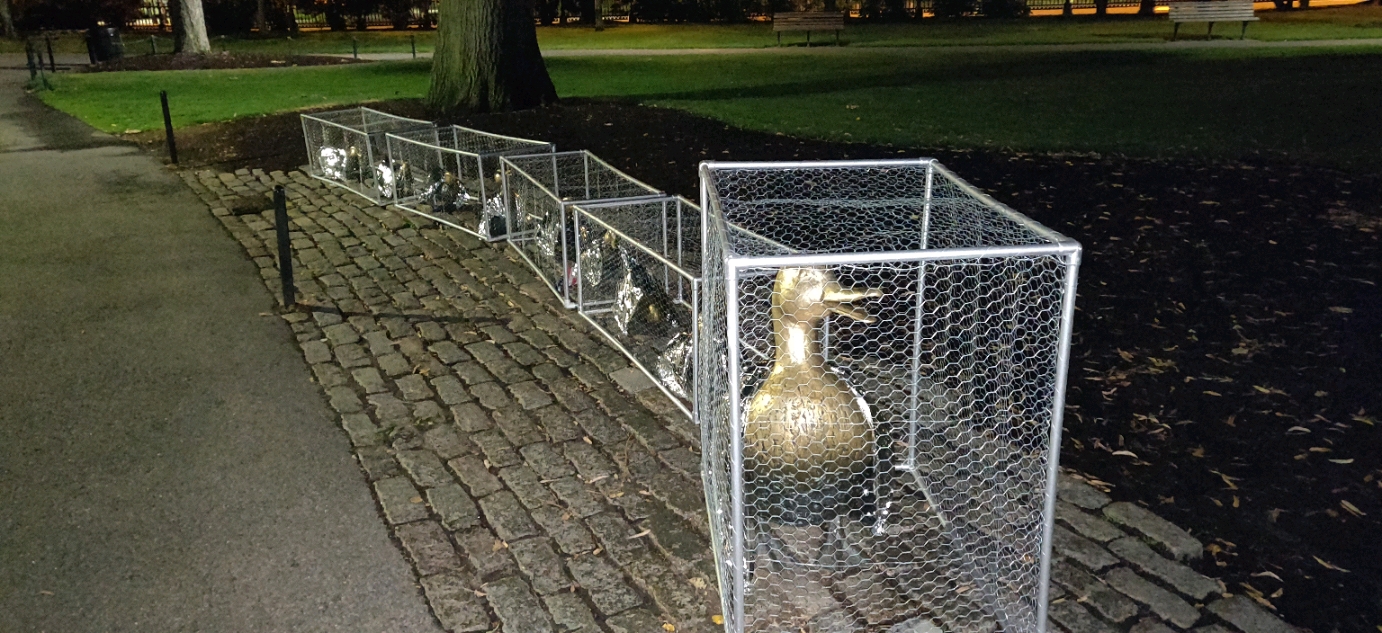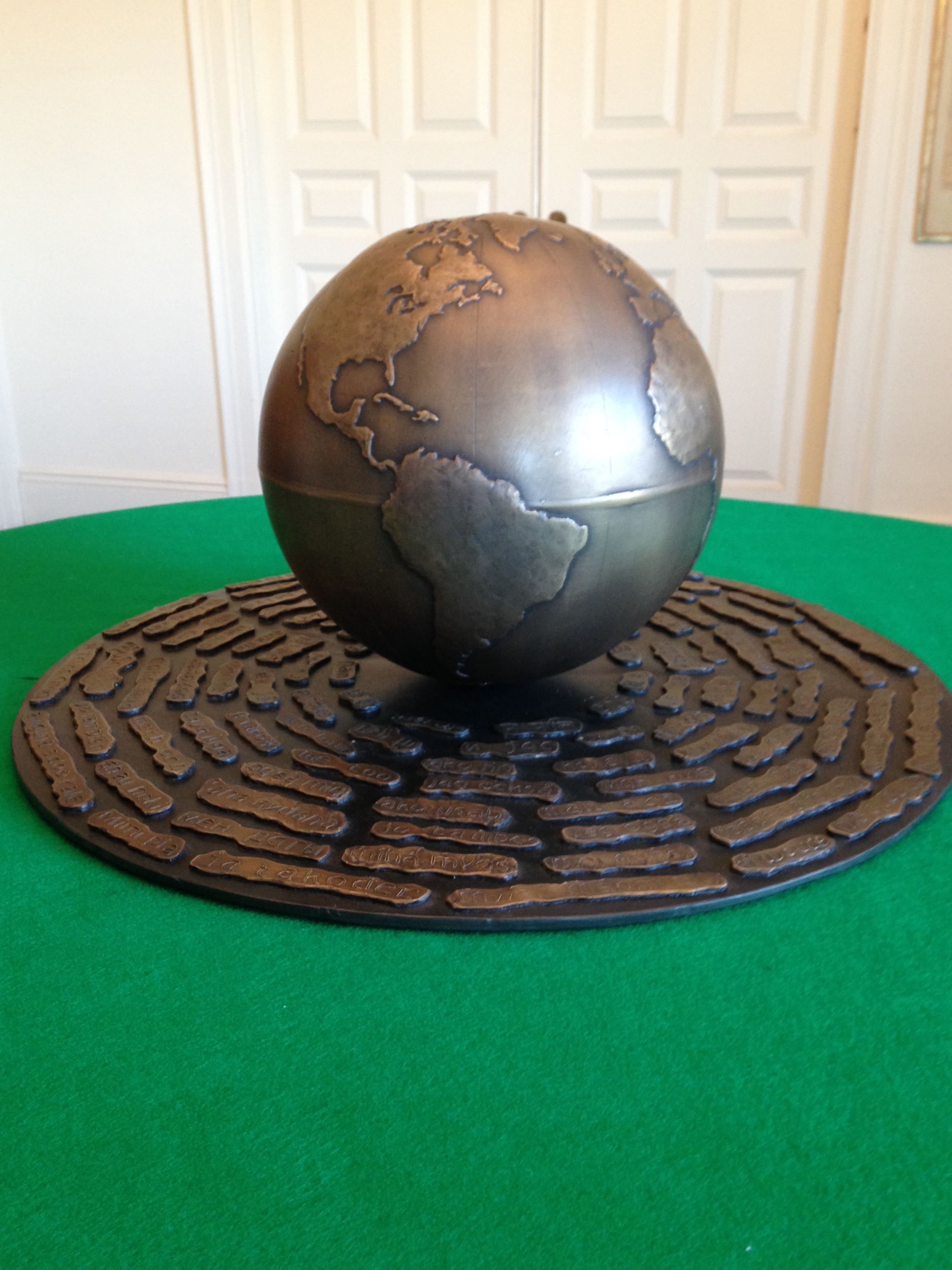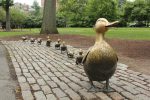Everybody in Boston knows the Mallard family. The sculpture of the iconic ducklings and their mother has graced Boston Garden for three decades. Based on Robert McCloskey’s classic book, “Make Way for Ducklings,” it calls up the story about a family of ducks that immigrates to Boston. The ducklings and their mother are an indispensable part of the Boston landscape. To that end, throughout the years the Mallard family has been dressed up for various Boston events—political and otherwise—including Red Sox T-shirts after the team won the World Series. They wore pink “pussy hats” in advance of the Women’s March in 2017. The ducks have also been annually dressed in Christmas regalia.
Related
Although Alzayer’s decision to use the ducklings to make a political statement was her own, Schön said, “She just did it and it was very thoughtful.” Alzayer told JewishBoston that the idea to place the individual ducks and their mother in cages and wrap them in the same mylar covers used as blankets at the border came to her “in a total flash around July 4. I was furious about having this nonchalant celebration when we had children in cages in our country. I saw on social media that the ducklings were decorated for Independence Day, and I thought if they were immigrating today, their fate would be to be in cages.”

While this is Alzayer’s first “activism-based” piece of public art, she has been a full-time henna artist for over two years. She sees a profound relationship between henna art and public art. “It seems like these two things aren’t similar, but they are,” she said. “The places that henna comes from are some of the most marginalized people in the world. It’s not lost on me that I do this artwork from cultures that have been discriminated against in our world.”
Alzayer further pointed out that henna is “such a joyful medium. You hold space with people and give them something specific just for them. I’ve brought my art to people to lift them up. Because I do this joyful work, it was even more poignant to make public art with the ducklings.”
The duckling project was a tactile one for Alzayer. She used 117 feet of PVC pipe and wrapped 75 feet of chicken wire around 300 yards of wire to attach the fencing to the frame. In the mix were the mylar coverings cut to fit the individual ducklings. “I did everything by hand,” she said. “I wanted to feel the materials. Chicken wire is a bear to work with—it’s sharp and cut me everywhere. I wanted to experience that.”

However, it was working with the mylar covers that brought Alzayer to tears. “When I got my hands on the mylar ‘blankets’ issued to the children on the border, I got really upset,” she recalled. “I thought to myself, ‘I can’t keep working on this.’ Mylar is loud. The crinkling sound they make is almost deafening when you’re wrapped in one. And when I thought of children, ripped away from their parents and given only this, it’s a lot to take in. But I needed to keep going. The image was obvious and no one else had done it. I needed to build it.”
Alzayer installed her work in the early morning hours of Aug. 2. Later that morning, park staff had taken it down, but not before Alzayer’s husband, Daud, took the only photo of the installation. He told CBS News, “[The installation] only stayed up for a few hours before park staff made it disappear, but I think the image speaks loudly even in a single photo.”
“[Karyn’s installation] is a powerful piece that was taken away too soon,” Schön said. “It’s incredible to have it during this time when we’re going through horrible things like separating families and taking babies away from their mothers. For someone to say something this powerful is pure genius, and I’m very grateful. Karyn and I are in touch, and we may try and collaborate.”

Schön’s commitment to social justice in public art is further evident in newer pieces she has sculpted. From her Aesop’s Fables collection, she has made a small sculpture of two goats butting their heads together that she calls “Congress.” She has a #MeToo sculpture, which she hopes to exhibit in the near future. “It’s a sculpture of the globe that is 12 inches in diameter and sits on a 25-inch platter,” she said. “Scattered across the plate are 106 islands representing 106 countries, and they all say #MeToo to show how harassment of women is a worldwide problem.”




